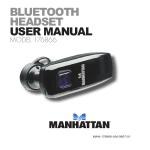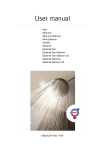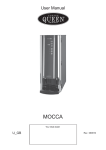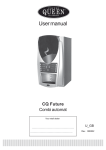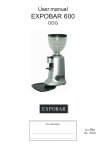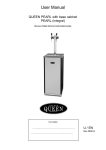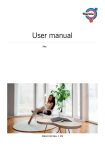Download Thermia Heat Pump Robust User Manual
Transcript
USER MANUAL Thermia heat pump Robust Eco VUIFE102 VUIFE102 Table of contents 1 Important information . . . . . . . . . . . . . . . . . . . . . . . . . . . . . . . . . . . . . . . . . . . 4 1.1 1.2 2 Safety precautions . . . . . . . . . . . . . . . . . . . . . . . . . . . . . . . . . . . . . . . . . . . . . . . . . . 4 Protection . . . . . . . . . . . . . . . . . . . . . . . . . . . . . . . . . . . . . . . . . . . . . . . . . . . . . . . . . 4 About your heat pump . . . . . . . . . . . . . . . . . . . . . . . . . . . . . . . . . . . . . . . . . . . 5 2.1 2.2 2.3 2.4 2.5 2.6 Product description . . . . . . . . . . . . . . . . . . . . . . . . . . . . . . . . . . . . . . . . . . . . . . . . . . 5 The principles of the heat pump . . . . . . . . . . . . . . . . . . . . . . . . . . . . . . . . . . . . . . . . . 5 Water heater . . . . . . . . . . . . . . . . . . . . . . . . . . . . . . . . . . . . . . . . . . . . . . . . . . . . . . . 6 System overview . . . . . . . . . . . . . . . . . . . . . . . . . . . . . . . . . . . . . . . . . . . . . . . . . . . . 6 Room sensor (option) . . . . . . . . . . . . . . . . . . . . . . . . . . . . . . . . . . . . . . . . . . . . . . . . 6 Piping installation . . . . . . . . . . . . . . . . . . . . . . . . . . . . . . . . . . . . . . . . . . . . . . . . . . . 6 3Operating instructions . . . . . . . . . . . . . . . . . . . . . . . . . . . . . . . . . . . . . . . . . . . 7 3.1 3.2 3.3 3.4 4 Checking the coolant circuit pressure . . . . . . . . . . . . . . . . . . . . . . . . . . . . . . . . . . . . . 7 Checking the water level in the heating system . . . . . . . . . . . . . . . . . . . . . . . . . . . . . . 7 Checking safety valves . . . . . . . . . . . . . . . . . . . . . . . . . . . . . . . . . . . . . . . . . . . . . . . 7 In the event of leakage . . . . . . . . . . . . . . . . . . . . . . . . . . . . . . . . . . . . . . . . . . . . . . . . 7 Troubleshooting . . . . . . . . . . . . . . . . . . . . . . . . . . . . . . . . . . . . . . . . . . . . . . . 8 4.1 Alarm . . . . . . . . . . . . . . . . . . . . . . . . . . . . . . . . . . . . . . . . . . . . . . . . . . . . . . . . . . . . 8 5 Terms and abbreviations . . . . . . . . . . . . . . . . . . . . . . . . . . . . . . . . . . . . . . . . . 9 6 References . . . . . . . . . . . . . . . . . . . . . . . . . . . . . . . . . . . . . . . . . . . . . . . . . . 10 VUIFE102 3 1 Important information This appliance is not intended for use by persons (including children) with reduced physical, sensory or mental ⚠⚠capabilities, or lack of experience and knowledge, unless they have been given supervision or instruction concerning use of the appliance by a person responsible for their safety. Children should be supervised to ensure that they do not play with the appliance. • If the installation is not used during the winter, the heating system must be drained of water, otherwise there is a risk of frost damage to the installation. Contact an authorized installer, see the “References” section for further information. • The system can be considered maintenance free but certain checks are necessary. • Before changing the control computer’s settings, first find out what these changes mean. See separate manual for the control system. • Contact your installer for any service work. 1.1 Safety precautions Installation and maintenance • Only authorized installers may install, operate and carry out maintenance and repair work on the heat pump. See the “References” section for more information. • Only authorized electricians may modify the electrical installation. See the “References” section for more information. ⚠⚠DANGER TO LIFE! • Only authorized refrigeration technicians may work on the refrigerant circuit. See the “References” section for more information. System modifications Only authorized installers may carry out modifications on the following components: • The heat pump unit • The pipes for the refrigerant, brine, water and power • The safety valve You must not carry out construction installations that may affect the operational safety of the heat pump. Safety valve The following safety precautions apply to the hot water circuit’s safety valve with corresponding overflow pipe: • Never block the connection to the safety valve’s overflow pipe. • Water expands when it is heated, this means that a small amount of water is released from the system via the overflow pipe. The water that exits the overflow pipe can be hot! Therefore, allow it to flow to a floor drain where there is no risk of burning yourself. 1.2 Protection Corrosion Protection Due to the risk of corrosion, avoid using different types of sprays in the vicinity of the heat pump. This particularly applies to: • Solvents • Chlorinated cleaning agents • Paints • Adhesives 4 VUIFE102 2 About your heat pump 2.1 Product description Robust Eco is a heating system for heating and hot water if an external water heater is installed. It has a compressor developed solely for heat pumps. Robust Eco is equipped with control equipment which is presented in a graphical display. The control equipment is also prepared for monitoring via the internet. Heat enters the house via a water borne heating system. The heat pump supplies as much of the heat demand as possible before auxiliary heating is engaged and assists. Robust Eco heating system consists oftwobasic units: Heat pump unit • Scroll compressor • Stainless steel heat exchanger, condenser, evaporator and de-superheater • Circulation pumps for collector- and heating system Control equipment The control equipment controls the components included in the heating installation (compressor, circulation pumps, auxiliary heaters and exchange valve) and determines when to start and stop the pump as well as producing heat for the house or hot water. The control equipment consists of: • Control computer, relay module, as well as operator’s panel with graphical display • Temperature sensors (outdoor, supply pipe, return pipe, brine, hot water and hot gas) • Room sensor (option) 2.2 The principles of the heat pump A heat pump utilises the energy found in a natural heat source. Simply put, it obtains energy in the form of heat from a heat source. The heat pump is, therefore, a very environmentally friendly and economical way of heating a house. 1. A fluid (brine) filled hose is lowered into a lake, buried in the ground or lowered into bedrock. The brine obtains energy from the heat source by the fluid temperature in the hose being heated a few degrees by the surrounding heat source. 2. The brine is guided into the heat pump’s evaporator. In the expansion valve, the pressure drops and is then forced through the evaporator and then evaporates. The energy produced during this process is released by the refrigerant. De-superheater Condenser 6 Heat transfer fluid circuit / Hot gas circuit Expansion valve/ pressure drop 5 4 3 Compressor/ pressure increasing Refrigerant circuit 2 Brine circuit Refrigerant Evaporator 1 Brine 3. The refrigerant that now contains a large quantity of energy in the form of heat is transferred to the compressor, which both increases its temperature and pressure. 4. The refrigerant then continues to the de-superheater. Here a small high temperature output is used, for example, to top up the hot water temperature 5. The gas then continues to the condenser. When condensing, the refrigerant supplies its heat energy to the heat transfer fluid circuit. The refrigerant’s temperature decreases and returns to a liquid state. 6. The heat transfer fluid circuit transports the heat energy out to the water heater, radiator and the under floor heating system, which heat up. The refrigerant is still hot when it has passed the condenser. The refrigerant is then transported through the expansion valve where the pressure drops and the process starts again. VUIFE102 5 The heat pump has four separate fluid circuits • Brine circuit – a water based mixture that transports energy from the heat source to the heat pump. • Refrigerant circuit – a circuit in the heat pump that through evaporation, compression and condensation takes energy from the refrigerant circuit and supplies it to the heat transfer fluid circuit. The refrigerant is chlorine free. • Heat transfer fluid circuit – the water that transports the heat/energy to the heating system and the water heater. • Hot gas circuit – is a high temperature circuit for the hot water circuit’s final heater. If the heat pump is not connected to any water heaters, the hot gas circuit does not need to be connected. 2.3 Water heater Robust Eco can also produce hot water for an external water heater. The water temperature of the hot water tank is controlled by the control switch and cannot be adjusted. Hot water production stops when the control pressostat reaches its maximum operating pressure. 2.4 System overview Robust Eco can be configured in a number of different combinations, one of which is shown below. The image illustrates a Robust Eco heat pump with four water heaters, the final heater of which is connected to the heat pump’s hot gas circuit. Additional shunt (0-10V) Heating system TWC TWC Communication CW HW Hot water HWC HWH HWH HWH HWH Robust Eco Hot gas circuit Brine 2.5 Room sensor (option) As an option, the heat pump system can be equipped with a room sensor of the Active type = 24 VAC 0-10V. Only authorised electricians may carry out the installation. For connection, see the separate manual for the control system. 2.6 Piping installation (Carried out in accordance with your Installer) 6 VUIFE102 3Operating instructions See separate manual for the control system. 3.1 Checking the coolant circuit pressure The brine circuit must be filled with the correct amount of fluid otherwise the installation may become damaged. Ensure that system has the necessary pressure, however, not above maximum pressure of 6 bar. See the installation instructions when filling brine: Filling the coolant system. Used when filling Connected to brine circuit 3.2 Checking the water level in the heating system The line pressure of the installation must be checked once a month. Ensure that heating system has the necessary pressure, however, not above maximum pressure of 6 bar. You can use normal tap water when topping up the heating system. In certain exceptional cases the water quality may be so poor (for example very hard water) that it is not suitable for filling the heating system. If unsure, contact your installer. (See “References” on page 12). Do not use any additives for water treatment in the heating system’s water! 3.3 Checking safety valves Both the safety valves for the heating system must be checked at least four times a year to prevent lime deposits clogging the mechanism. The safety valve of the water tank protects the enclosed heater against over pressure in the water tank. It is mounted on the cold water inlet line, its outlet opening facing downwards. If the safety valve is not checked regularly, the water tank might be damaged. It is quite normal that the safety valve lets out small amounts of water when the water tank is being charged, especially if a lot of hot water was used previously. Both safety valves can be checked by turning the cap a quarter of a turn clockwise until the valve lets out some water through the overflow pipe. If a safety valve does not work properly, it must be replaced. Contact an authorized installer, see the “References” section for further information. The opening pressure of the safety valves is not adjustable. 3.4 In the event of leakage In the event of leakage in the hot water pipes between the unit and water taps, close the shut-off valve on the cold water inlet immediately. Contact your installer. See the “References” section for more information. In the event of leakage in the brine circuit, turn off the heat pump and call your installer immediately. See the “References” section for more information. VUIFE102 7 4 Troubleshooting 4.1 Alarm Message Meaning Cause Remedy LOW PRESS ERROR Low pressure error - The compressor stops and there is no hot water production. Not enough fluid in the brine system. Contact your installer. High pressure error - The compressor stops and there is no hot water production. Insufficiently opened radiator/floor loop thermostats. Open radiator / floor loop thermostats. Air in the heating system. Fill and bleed the heating system Blocked strainer in the heating system. Contact your installer. Motor protection cut out. The compressor stops and there is no hot water production. Power failure due to a blown fuse. Check the fuses HIGH PRESS ERROR MOTOR P ERROR Air in the brine system. Blocked filter in the brine system. Over current relay has deployed. For other alarms, see separate manual for the control system. 8 VUIFE102 Reset the safety switch. 5 Terms and abbreviations Evaporator In the evaporator, energy from the heat source is absorbed by the refrigerant passing through the evaporator. The refrigerant turns into gas. (See “Heat Pump Principle” for further information.) INTEGRAL “INTEGRAL” is the heat system’s energy balance. Heat generation is controlled by a calculated requirement. This value is determined by comparing the actual supply temperature with its calculated supply temperature. The difference between the temperatures is multiplied by the time during which the difference is active. The resulting value is referred to as the integral. The integral value is automatically established when the heating system is in use. Compressor The compressor raises the temperature and pressure of the refrigerant. (See “Heat Pump Principle” for further information.) Condenser In the condenser, the refrigerant supplies its heat energy to the heat transfer fluid circuit. (See “Heat Pump Principle” on page 5 for more information.) Brine Is a water based mixture that transports energy from the heat source to the heat pump. (See “Heat Pump Principle” for further information.) Brine circuit The fluid circuit transports energy from the heat source to the heat pump. (See “Heat Pump Principle” on page 5 for more information.) Refrigerant circuit Is the circuit in the heat pump that through evaporation, compression and condensation takes energy from the brine circuit and supplies it to the heat transfer fluid circuit. (See “Heat Pump Principle” for further information.) Refrigerant Is the fluid that transports heat from the brine circuit and supplies it to the heat transfer fluid circuit. (See “Heat Pump Principle” for further information.) De-superheater In the de-superheater part of the total heating output is released (approx. 15%). A higher temperature than the normal condensation temperature can found here. Radiator Heater element, element. Heat transfer fluid circuit The fluid circuit obtains heat/energy from the refrigerant circuit, which it then transports to the hot water tank or radiator and floor heating system. (See “Heat Pump Principle” for further information.) Heat curve The control computer determines the correct temperature of the water to be distributed to the heating system based on the heat curve. The indoor temperature is adjusted by changing the gradient of the heating system’s “CURVE”. See separate control instructions. VUIFE102 9 6 References Installation and commissioning have been carried out by: Piping installation Date: Company Name: Telephone no.: Electrical Installation Date: Company Name: Telephone no.: System adjustment Date: Company Name: Telephone no.: Thermia Värme AB retains the right to make changes to components and specifications without prior notice. 10 VUIFE102 VUIFE102 11 If these instructions are not followed during installation, operation and maintenance Thermia Värme AB’s liability according to the applicable warranty is not binding. Thermia Värme AB • Box 950 • SE-671 29 Arvika www.thermia.se VUIFE102












